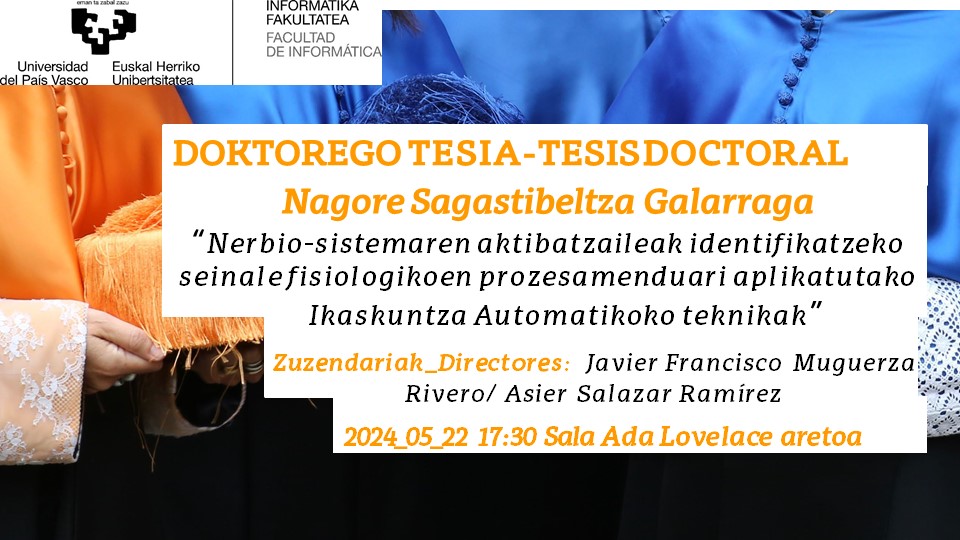2024_05_22; 11:00 Doctoral Thesis Defence Nagore Sagastibeltza Galarraga
First publication date: 15/05/2024

Nagore Sagastibeltza Galarraga: "Nerbio-sistemaren aktibatzaileak identifikatzeko seinale fisiologikoen prozesamenduari aplikatutako Ikaskuntza Automatikoko teknikak"
Zuzendariak_Directores: Ana Jesús Arruarte Lasa / Mikel Joseba Zorrilla Berasategui
2024_05_22, 17:30 Sala Ada Lovelace aretoa.
Abstract:
"Currently, the conception of health has expanded towards the comprehensive well-being of the patient, recognizing its scope beyond mere absence of diseases, including physical, mental, and social aspects. Given the changing requirements of the healthcare system, engineering and computer sciences are orientating towards the development of technologies that improve medical diagnostics and reduce costs in disease detection, covering a variety of situations that may go from the design of innovative drugs to the development of whole preventive medical programs. To achieve these goals, some research groups in the field of physiological computing are dedicated to creating computer systems that identify patterns in physiological signals. The use of these applications and systems goes beyond the mere medical diagnosis and are also useful for identifying and detecting people’s mental and emotional states. This way, the importance of interdisciplinary collaboration between the worlds of medicine and engineering becomes evident, emphasizing the need to seek synergies between these two disciplines in order to produce significant social, clinical, and technological progress in disease prevention, early detection and diagnosis.
In this context, this thesis essentially deals with two research lines. The first focuses on the detection of episodes of autonomic dysreflexia in patients with cervical or high dorsal spinal cord injuries. After suffering a spinal cord injury, the local circuits that are regulated by sympathetic neurons may also suffer plastic changes. The main goal of this line is to develop a Machine Learning-based system to address the challenge of the initial diagnosis of autonomic dysreflexia in patients with spinal cord injuries, minimizing the need to use invasive methods for such diagnosis. To achieve this objective, this thesis proposes using a hierarchical classification system that divides the diagnosis into two levels and that only uses features that can be extracted non-invasively. In summary, the contribution made in this line poses the hypothesis that it is possible to perform the initial diagnosis of the disease through Machine Learning-based systems and non-invasive features.
On the other hand, the second research line focuses on the automatic detection of mental states. This line starts with the premise that emotional changes, especially in situations of stress and relaxation, have a direct impact on the individual’s autonomic nervous system. The autonomic nervous system has such a high sensitivity that the physiological changes that occur when a person relaxes are different depending on whether they occur in a stressful or calm situation. Thus, this line of research specifically targets the automatic detection and identification of different emotional substates within a specific mental state: relaxation."


